Introduction
Everest Base Camp Trek route is one of the best routes for treks in Nepal. It holds amazing views which will make you fall in love with this place. The cultural exploration, and a sense of achievement is like no other. In this detailed overview, we will understand the various aspects of this iconic famous Everest Base Camp Trek route, providing valuable insights and practical tips for anyone considering this extraordinary journey.
Table of Contents
Key Highlights of the Article:
- Exploration of the Trek route: We will take you through each stage of the trek, from the great exhilarating start in Lukla to the final push to Everest Base Camp and beyond.
- Cultural Encounters: Discover the rich traditions of the Sherpa people and the serene beauty of Buddhist monasteries along the way.
- Challenges and Preparations: Learn how to tackle altitude-related obstacles and make the most of your trekking experience.
1. Mount Everest Base Camp: Where Adventure Begins for the Everest Base Camp Trek route
1.1 Lukla: The Gateway to the Himalayas
The famous Mount Everest Base Camp Trek route begins in the charming town of Lukla, which lies in the majestic Himalayas.
Lukla is a lively place. It perfectly combines the rich Sherpa culture with all the modern conveniences that trekkers need. The town is always buzzing with energy, as adventurers from around the world gather here, eager to tackle the adventure of a lifetime and set their sights on reaching Everest Base Camp.
Insights into Lukla, the thrilling airport experience
One of the highlights of starting your trek in Lukla is the thrilling airport experience. Tenzing-Hillary Airport in Lukla is world famous for its short and steep runway. Thus, it is well known as one of the most dangerous airports in the world.
As you fly towards Lukla, get ready to be wowed by the stunning snow-covered mountains and the valleys below. Feel the excitement build as the plane quickly descends onto the runway, giving you a thrilling experience you will never forget.
Once you land safely in Lukla, you will be greeted by friendly locals offering warm smiles and traditional greetings. The town itself is bustling with activity, with colorful tea houses, shops selling trekking gear, and vibrant markets where you can stock up on supplies.
Lukla also serves as an important acclimatization point before starting your ascent towards Everest Base Camp. It allows your body to adjust to the altitude gradually, reducing the risk of altitude sickness and ensuring a safer trekking experience.
Take a moment to enjoy the vibrant atmosphere of Lukla as you sip on a steaming cup of tea or coffee before you begin your trek. The lively energy of the town is sure to ignite your excitement for the incredible adventure to the Everest Base Camp.
1.2 Phakding: First Glimpse of the Trekking Trail
Once you start your trek from Lukla, the beginning of the Everest Base Camp route, you will head towards Phakding. This part of the journey gives you a taste of what’s to come, with stunning scenery and challenging terrain along the way. Get ready for an unforgettable adventure on the Everest region!
The Path from Lukla to Phakding
The trail from Lukla to Phakding on the Everest Base Camp Trek route presents trekkers with diverse landscapes. You will encounter it throughout the expedition. As you trek this route, you will experience:
- Dense cool forests
- Amazing suspension bridges
- Captivating glimpses of distant snow-capped peaks
Teahouses and Rest Stops
Along this Everest Base Camp Trek route, trekkers will encounter several charming tea houses where they can:
- Take a break
- Enjoy a warm beverage
- Savor local cuisine
- Meet other trekkers
These pit stops provide opportunities to interact with fellow trekkers and gain insights into the experiences awaiting further along the trail on the Everest Base Camp Trek route.
Scenic Surroundings
The journey to Phakding is filled with stunning natural scenery, including:
- Rushing rivers
- Verdant hillsides
This part of the journey gives you a glimpse of the stunning landscapes that will make trekkers feel connected to nature.
The journey from Lukla to Phakding is like the exciting beginning of a thrilling adventure towards the destination. This Everest Base Camp Trek route gets you pumped up for the amazing experiences waiting for you along the way.
2. Enchanting Villages along the Path
As you begin your trek on the Everest Base Camp Trek route, you will have the opportunity to explore and experience several enchanting villages along the route. Each village has its own unique features and cultural significance, adding depth to the journey through the Himalayas on the Everest region.
Namche Bazaar
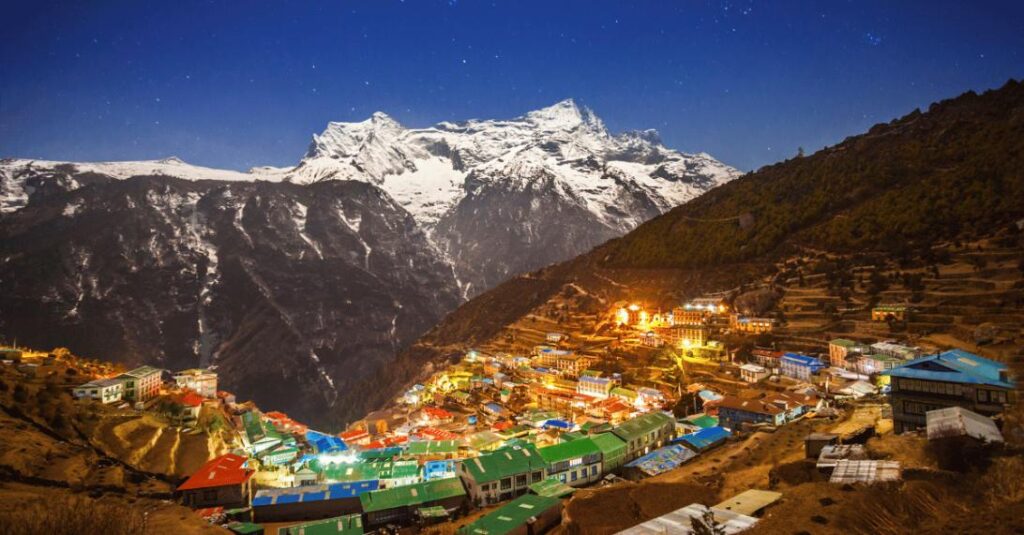
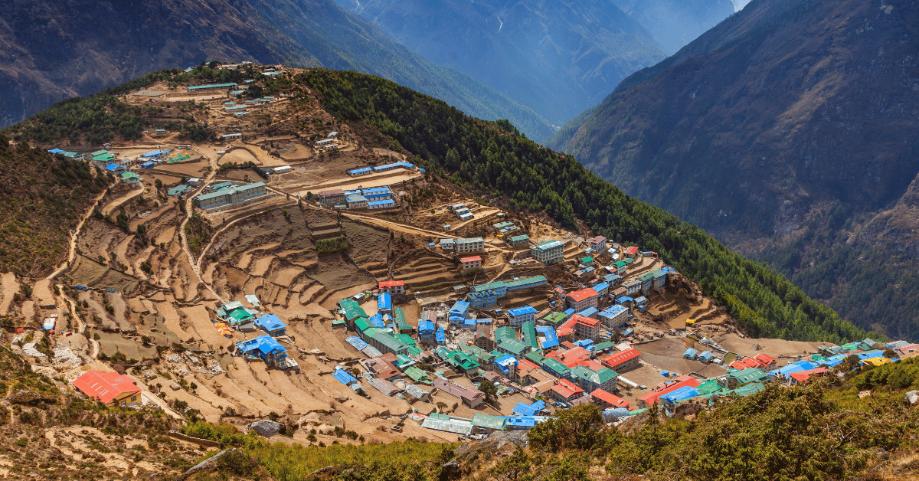
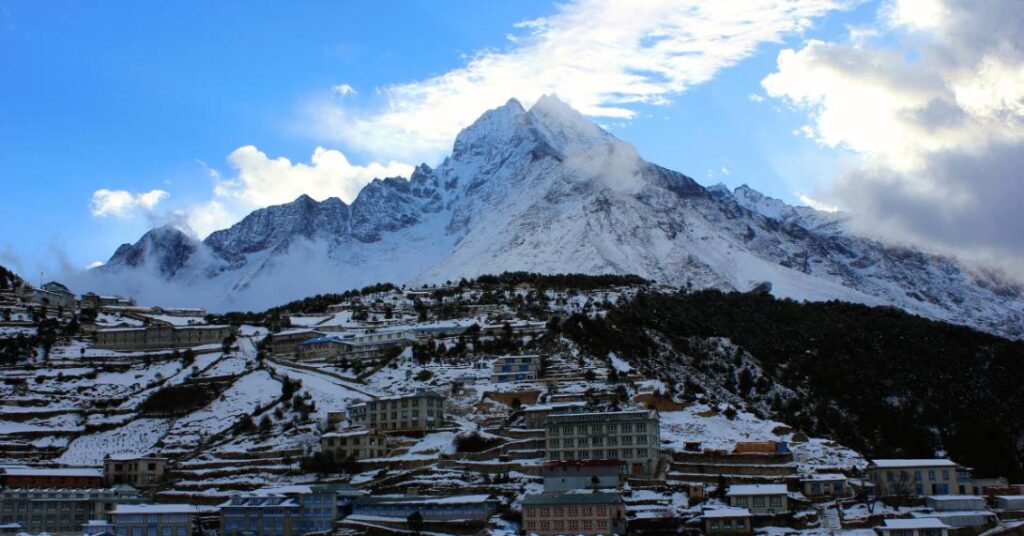
Namche Bazaar, also known as the “Gateway to Everest,” is a lively village in the Everest region and an important trading center. It is a great place to learn about Sherpa culture, try delicious local food at cozy teahouses and bakeries, and gain insight into life in remote Nepalese communities. You will come to appreciate the little things in life.
Explore the bustling streets filled with shops selling trekking gear, handmade crafts, and souvenirs. Don’t miss the Saturday market, where you can experience the local way of life firsthand.
Tengboche
The quaint village of Tengboche is where time seems to move just a little bit slower. As you follow the winding path leading to the ancient Buddhist monastery, you can’t help but pause to admire the breathtaking panorama of Mount Everest and the other Himalayan giants surrounding you.
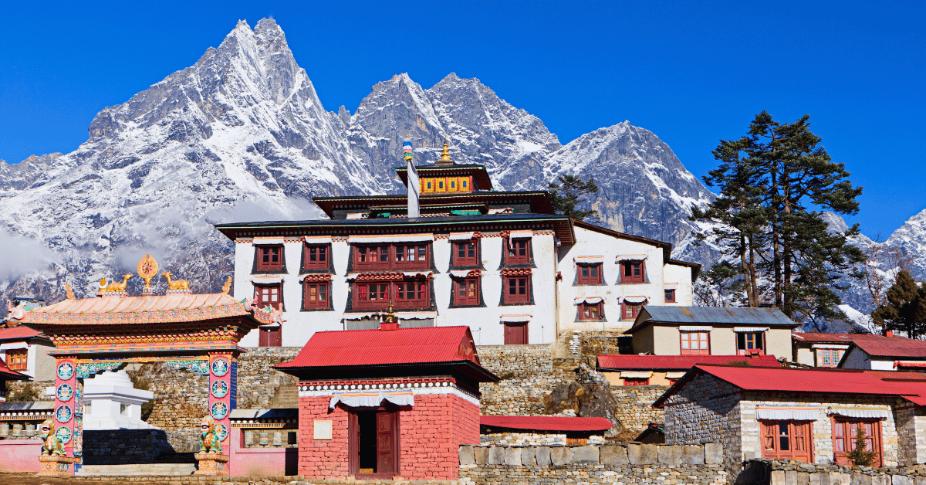
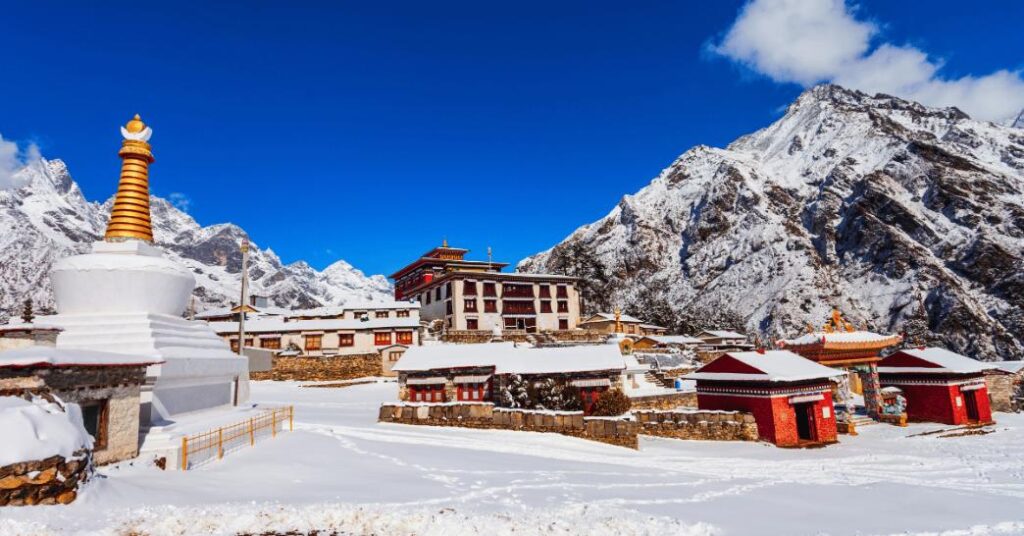
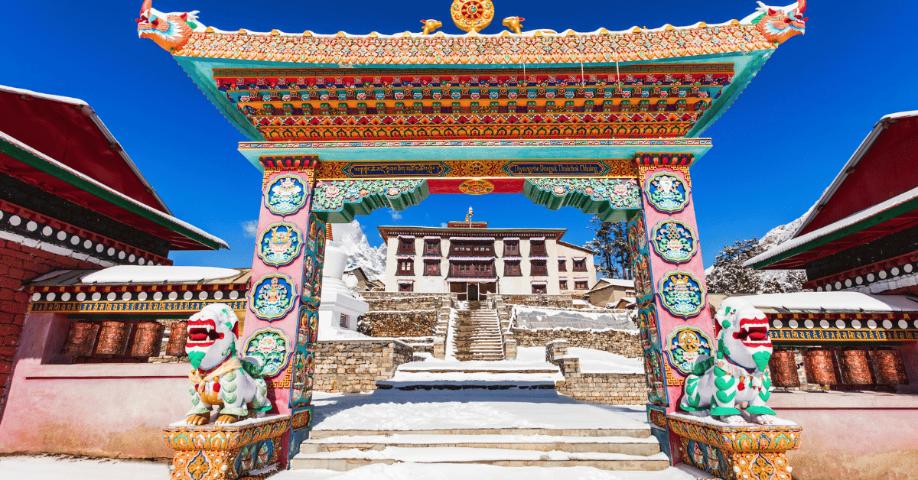
Inside the monastery’s weathered walls, you can almost hear the fluttering of prayer flags in the wind. If you time your visit right, you may catch a glimpse of the maroon-robed monks gathered in the temple, their mesmerizing chanting transporting you to another world. Attend the morning puja to experience their palpable spirituality firsthand. The hypnotic humming of mantras and the scent of burning incense have a way of stirring something deep inside your soul.
Stay awhile after the prayers are done. Sit amongst the monks and local villagers who are always happy to share a cup of Tibetan tea with newcomers and regale you with tales of this sacred place. You may even join them in spinning the ancient prayer wheels, sending blessings out into the universe with each turn.
Tengboche fills you with immense inner peace and a sense of communion with forces much larger than yourself. The connection you forge here will remain within your heart long after you wander back down the rhododendron path, returning from this magical realm.
Dingboche
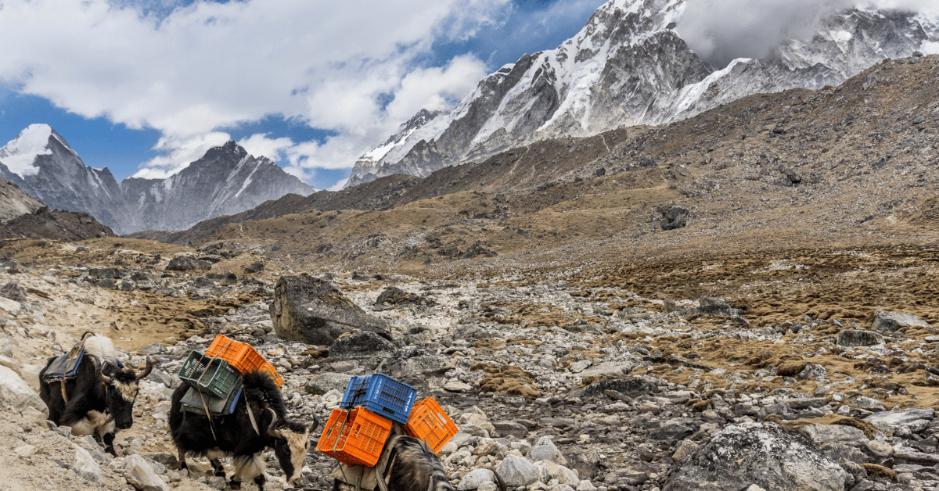
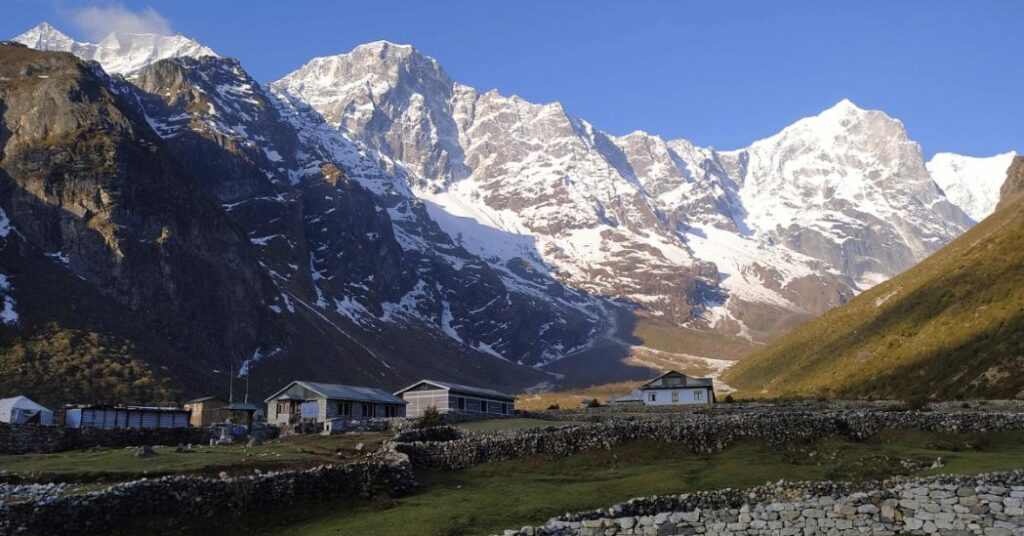
Village of Dingboche will get you surrounded by some of the world’s most breathtaking peaks. From here, you can sooth your eyes on breathtaking views of mountains like Lhotse and Island Peak. It’s the perfect place to take a break, get used to the altitude, and enjoy a leisurely walk around the village. Don’t forget to chat with the friendly locals and embrace the peaceful vibes all around you.It feels different and yes, it definitely feels better.
Lobuche
As you approach higher altitudes, Lobuche becomes a resting point before your final push towards the Base Camp on your journey of Everest Base Camp Trek route. The village offers panoramic views of the mountains and serves as a base for climbers preparing for their ascent. Explore the nearby memorials dedicated to mountaineers who lost their lives on Everest.
Gorak Shep
The last village before reaching Everest Base Camp, on your Everest Base Camp Trek route is Gorak Shep. It is located at the foot of Kala Patthar and is a very popular overnight stop for trekkers who want to catch the sunrise from Kala Patthar before continuing their journey to Base Camp. From Gorak Shep, you can witness the stunning Khumbu Glacier and the iconic Everest Base Camp.
These villages not only provide essential accommodation and rest but also offer opportunities to connect with local Sherpa communities, learn about their traditions, and witness the beauty of the Himalayas. Each village has its own charm and significance, adding layers of cultural and natural exploration to your Everest Base Camp trek route
Remember to respect local customs and traditions while visiting these villages, as they are an integral part of the unique experience that awaits you on this extraordinary journey through the Himalayas.
3. Cultural Learnings: People and Monasteries
Experiencing the best of Sherpa cultures and traditions along with Buddhist monasteries is an integral part of the Everest Base Camp Trek route. As you make your way through the Sherpa villages, you will have the opportunity to understand their fascinating way of life and witness their deep connection to Buddhism.
The Sherpa People: Resilient Mountaineers
The Sherpas are an ethnic group native to the Himalayas, particularly known for their resilience and expertise in mountaineering. These warm-hearted and friendly people will welcome you with open arms, offering a glimpse into their unique culture. You will have the chance to interact with them, learn about their traditions, and gain insights into their daily lives.
Buddhist Monasteries: Spiritual Sanctuaries
One of the highlights of the cultural aspect of the Everest Base Camp Trek route is visiting the Buddhist monasteries. These monasteries serve as spiritual sanctuaries for both locals and trekkers alike. Inside these serene temples, you can witness monks chanting prayers, spinning prayer wheels, and lighting butter lamps.
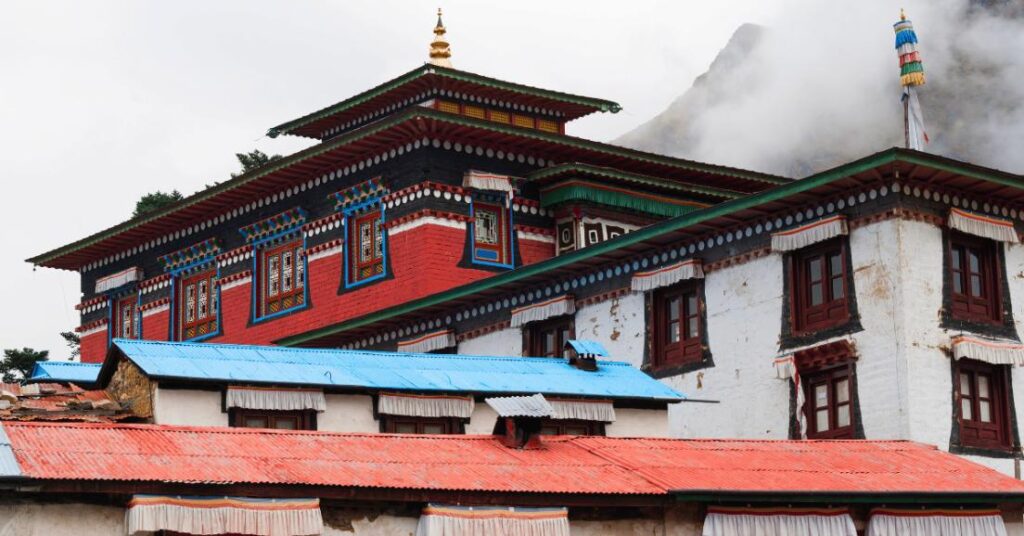
- Tengboche Monastery: Located at an elevation of 3,867 meters, this is one of the most famous monasteries on the Everest Base Camp trek route. It holds great religious significance for the Sherpa community. The morning prayers at Tengboche Monastery offer a tranquil experience as you enjoy the panoramic views of majestic mountains like Ama Dablam and the Everest.
- Pangboche Monastery: Renowned for its ancient artifacts and sacred relics, this monastery provides a glimpse into the rich history and spiritual heritage of the region.
Exploring the Sherpa culture and visiting these monasteries not only adds depth to your trekking experience but also allows you to appreciate the spiritual significance that permeates through every aspect of life in this remote mountainous region.
“As I entered Tengboche Monastery, I was engulfed in a sense of serenity. The sound of the monks’ prayers resonated through the halls, creating an atmosphere of tranquility. I sat down, closed my eyes, and took a moment to appreciate the spiritual energy that surrounded me. It was a humbling experience that left a lasting impression on my journey to Everest Base Camp.”
- Valeria García, Spain
4. Majestic Viewpoints on the Everest Base Camp Trek Route
Scenic Beauty from Nangkartshang Peak and Kalapattar
The Everest Base Camp trek offers breathtaking views from two key viewpoints along the route: Nangkartshang Peak and Kalapattar.
Nangkartshang Peak
This lesser-known viewpoint provides a stunning panoramic vista of the Himalayan range, including Everest, Lhotse, Ama Dablam, and more. The tranquil surroundings and the sense of solitude make it a serene spot for trekkers to absorb the grandeur of the mountains.
Kalapattar
Renowned as one of the best vantage points for witnessing Mount Everest, Kalapattar offers an awesome inspiring sunrise view of the world’s highest peak. Trekkers often undertake an early morning ascent to witness the golden hues of dawn illuminating Everest and neighboring peaks in all their glory.
These viewpoints provide an opportunity for trekkers to capture mesmerizing photographs and create lasting memories of their Everest Base Camp journey. The sheer magnificence of these vistas serves as a reminder of the unparalleled beauty that awaits adventurers along this iconic trekking route.
5. Dealing with Altitude Challenges
Altitude challenges are a significant aspect of the Everest Base Camp Trek. As you ascend higher into the Himalayas, the air becomes thinner, and the oxygen levels decrease. Altitude sickness, also known as acute mountain sickness (AMS), can occur when your body doesn’t adapt well to the high altitude. It is essential to understand the risks associated with altitude sickness and take necessary precautions to ensure a safe and enjoyable trek.
Understanding the Risks
Altitude sickness can affect anyone, regardless of age, gender, or physical fitness level. The symptoms can range from mild to severe and may include:
- Headache
- Nausea
- Dizziness
- Fatigue
- Loss of appetite
- Difficulty sleeping
In rare cases, it can lead to more severe conditions such as high-altitude pulmonary edema (HAPE) or high-altitude cerebral edema (HACE).
Importance of Acclimatization
Acclimatization is crucial during the Everest Base Camp Trek to allow your body to adjust gradually to the increasing altitude. It involves taking rest days at specific elevations to give your body time to adapt. The two most common acclimatization points on the route are Namche Bazaar (3,440 meters) and Dingboche (4,410 meters). These rest days allow your body to produce more red blood cells and increase oxygen-carrying capacity.
Tips for Managing Altitude-Related Challenges
To minimize the risk of altitude sickness and manage altitude-related challenges effectively, here are some important tips:
- Ascend slowly: Gradual ascent is vital for acclimatization. Avoid gaining more than 300-500 meters in elevation per day.
- Stay hydrated: Drink plenty of fluids throughout the trek to stay hydrated and help prevent altitude sickness.
- Listen to your body: Pay attention to any symptoms or signs of altitude sickness. If you experience severe symptoms, descend to a lower altitude immediately.
- Follow a balanced diet: Eat a diet rich in carbohydrates and avoid excessive alcohol consumption.
- Take acclimatization hikes: During rest days, take short hikes to higher elevations and then descend back to your accommodation for better acclimatization.
- Consider medication: Consult with your doctor about taking medications like acetazolamide (Diamox) to help prevent altitude sickness.
By understanding the risks, prioritizing acclimatization, and following these tips, you can minimize the chances of altitude-related challenges and make the Everest Base Camp trek a safe and enjoyable experience.
Best Time for Mount Everest Base Camp Journey
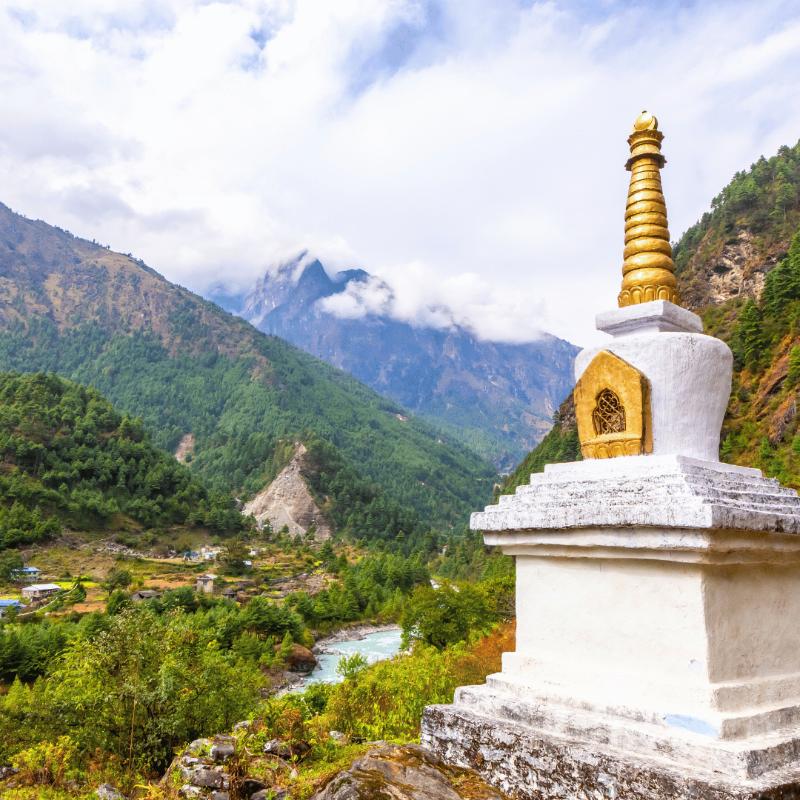
When planning your trek to Everest Base Camp, it is crucial to consider the best time to embark on this adventure. The weather and the overall conditions along the route can greatly impact your experience. Here’s an overview of the best seasons for the trek:
1. Spring (March-April)
This is considered the peak season for the Everest Base Camp trek. The weather during spring is generally stable with mild temperatures, clear skies, and blooming rhododendron forests. However, be prepared for larger crowds on the trail.
2. Autumn (mid-September to mid-November)
Another excellent time to undertake this journey is during autumn. The weather is dry and stable, offering crystal-clear views of the majestic Himalayan peaks. The trails are less crowded compared to spring, making it a popular choice among trekkers.
3. Winter (December-February)
Although winter brings colder temperatures and occasional snowfall, it can still be a rewarding time for experienced trekkers who enjoy solitude and quieter trails. However, be aware that certain sections of the route may be closed due to heavy snowfall.
4. Monsoon season (June-August)
It’s generally advisable to avoid trekking during the monsoon season due to heavy rainfall, slippery trails, and limited visibility. The risk of landslides also increases during this time.
By choosing the right season for your Everest Base Camp journey, you can maximize your chances of clear views, comfortable weather conditions, and a more enjoyable trekking experience. Remember to check weather forecasts and consult with local guides or trekking agencies for up-to-date information before finalizing your travel plans.
Note: These are general guidelines; individual experiences may vary depending on weather patterns and personal preferences.
7. Duration, Distance, and Difficulty Level
When planning your Mount Everest Base Camp trek, it’s important to have a clear understanding of the duration, distance, and difficulty level involved. Here are some key points to consider:
Average Duration
The classic Everest Base Camp trek typically takes around 12 days to complete. This includes acclimatization stops in Namche Bazaar and a climb to Kala Patthar for stunning views of Mount Everest. However, the total duration can vary depending on factors such as fitness level, acclimatization needs, and weather conditions.
Total Distance Covered
The total distance covered during the trek is approximately 130 kilometers (80 miles). This includes both ascending and descending sections of the trail.
Daily Walking Distances
On average, trekkers cover a distance of about 10 kilometers (6 miles) per day. However, it’s important to note that the daily walking distances can vary depending on the terrain, altitude gains, and individual pace.
Difficulty Level
The Everest Base Camp trek is considered moderately challenging. While you don’t need technical climbing skills, it does require a good level of physical fitness and endurance. The trail involves steep ascents and descents, rocky terrain, and high altitude conditions. It’s crucial to be prepared for the physical demands of the trek by undertaking cardiovascular training before embarking on the journey.
By having a clear understanding of the duration, distance, and difficulty level of the Everest Base Camp trek, you can better plan your itinerary and ensure a safe and enjoyable experience on this epic adventure in the Himalayas.
8. Resting in the Lap of the Himalayas: Teahouse Experience
One unique aspect of trekking to Everest Base Camp is the opportunity to stay at tea houses along the route. These traditional mountain lodges offer basic accommodation and meals, providing a cozy resting place for trekkers. Here’s what you need to know about teahouse experience:
Staying at Teahouses
Teahouses are scattered along the Everest Base Camp trek route, allowing trekkers to break their journey into manageable segments. This makes it easier for both beginners and experienced hikers to plan their daily distances.
Facilities and Services
Facilities at teahouses can vary from basic to relatively comfortable, with options for private or shared rooms. Common areas often have wood-burning stoves, offering warmth and a place to socialize with other trekkers.
Services typically include:
- Hearty meals: Trekkers are usually served traditional Nepali dishes like dal bhat (rice with lentil soup) or noodles.
- Hot showers (for a fee): Some tea houses have hot shower facilities, but they may come at an additional cost.
- Charging facilities for electronic devices: Limited access to electricity is available, so it’s important to bring a portable charger.
Tips for Choosing and Booking Teahouse Accommodation
When choosing teahouse accommodation, consider factors such as cleanliness, food quality, and the overall atmosphere. Here are some tips to help you make the right choice:
- Research: Look up reviews or ask for recommendations from fellow trekkers who have recently completed the Everest Base Camp trek.
- Pack light: Keep in mind that you’ll be carrying your own backpack throughout the trek, so pack only essential items.
- Be flexible: During peak trekking seasons, teahouses can get crowded. It’s advisable to have a backup plan or be open to staying at alternative tea houses along the route.
- Book in advance: To ensure availability, especially for popular teahouses, it’s recommended to book in advance, especially during peak trekking seasons.
By providing insights into the teahouse experience and tips for selecting accommodations, trekkers can better prepare for this aspect of their Everest Base Camp journey.
9. Side Excursions for Extra Delight
While the Everest Base Camp trek itself is a remarkable adventure, there are also optional side excursions that can add extra delight to your journey. These side trips allow you to explore nearby areas and experience more of the stunning Himalayan landscape. Here are a few options to consider:
- Pheriche: Located at an altitude of around 4,240 meters, Pheriche is a small village renowned for its charming beauty and breathtaking views. It is a popular acclimatization stop on the Everest Base Camp route and offers opportunities for short hikes and walks in the surrounding areas. Pheriche also has a high-altitude medical clinic where trekkers can learn about altitude sickness and its prevention.
- Syangboche: Situated at an elevation of approximately 3,800 meters, Syangboche is known for its panoramic views of Mount Everest and other towering peaks. You can reach Syangboche by taking a scenic helicopter flight from Lukla or by trekking through Namche Bazaar. In addition to relishing the awe-inspiring vistas, you can also visit the Everest View Hotel, which offers an incredible perspective of the world’s highest mountain.
- Khumjung Village: Nestled at an altitude of around 3,790 meters, Khumjung is a traditional Sherpa village that provides insights into the local culture and way of life. This village is famous for its Hillary School, established by Sir Edmund Hillary in 1961, as well as its ancient monastery that houses a purported Yeti scalp. Exploring Khumjung allows you to understand Sherpa traditions and appreciate the warm hospitality of the local community.
These side excursions offer additional opportunities to connect with nature, delve into Sherpa culture, and witness extraordinary vistas beyond the main Everest Base Camp trail. Whether you choose to visit Pheriche, Syangboche, Khumjung Village, or all three, these side trips will undoubtedly enhance your overall trekking experience. So, consider incorporating these optional excursions into your itinerary and make the most of your time in the Himalayas.
“The side excursions from the Everest Base Camp route provide trekkers with a chance to explore lesser-known areas and discover hidden gems amidst the breathtaking Himalayan scenery.”
Conclusion
The cost of the Everest Base Camp trek can vary based on factors such as the duration of the trek, the choice of accommodations, and the inclusion of guided tours or porter services. It’s essential to budget for permits, meals, accommodations, and any additional expenses.
The Everest Base Camp trek is a transformative experience that offers unparalleled natural beauty, cultural insights, and personal achievement. The journey to the base of the world’s highest peak is both challenging and rewarding, leaving a lasting impression on all who undertake it.
Going on the Everest Base Camp trek in Nepal is an opportunity to explore the grandeur of the Himalayas and to connect with the warm hospitality of the Nepalese people. Start planning your adventure and get ready for an unforgettable expedition to this iconic destination.
Send an Enquiry
Error: Contact form not found.
© 2025 - Himalayan Trekking and Tours (P) Ltd. All Rights Reserved.

